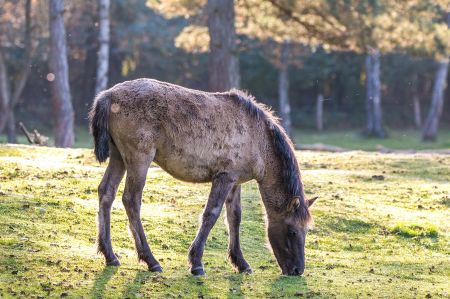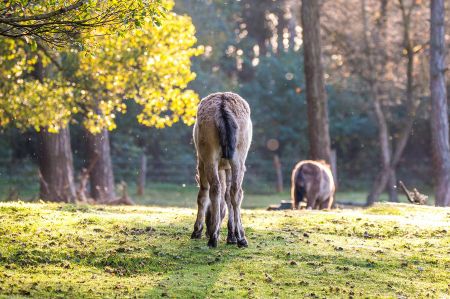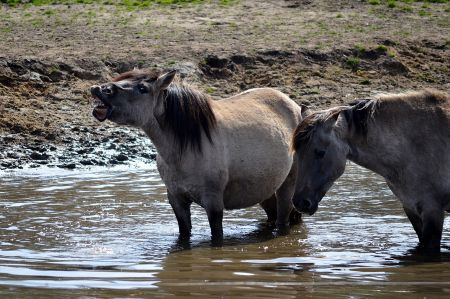Just as interesting as the high-powered Wiesmann Roadsters produced in Dülmen at the time are their natural counterparts: the Dülmen wild horses.
We first noticed the horse affinity when we frequently came across the term “horse” in various names of streets, buildings or squares during our city tour. In fact, the Dülmener horse, also known as the Dülmener wild horse, is more of a pony or small horse breed that originated from the Emscherbrucher and lives mainly in Dülmen in the Merfelder Bruch, a nature reserve covering around 350 hectares. Around 300 to 400 horses live in the fenced-in area, also known as the wild horse track, largely unaffected by humans.
Origin and allocation of small horses
 The Dülmener horse is a breed of horse that looks quite original, mostly brown or grey-fawn in colour, which has the dorsal stripe from the mane to the tail that is typical of wild horses. There are duns of all shades, but occasionally other colours, but there is hardly any grey. Foxes are also very rare. However, due to previous "breeding" dun and grey dun animals with a dorsal stripe and rarely a shoulder cross dominate.
The Dülmener horse is a breed of horse that looks quite original, mostly brown or grey-fawn in colour, which has the dorsal stripe from the mane to the tail that is typical of wild horses. There are duns of all shades, but occasionally other colours, but there is hardly any grey. Foxes are also very rare. However, due to previous "breeding" dun and grey dun animals with a dorsal stripe and rarely a shoulder cross dominate.
There may be dark stripes on the legs, reminiscent of a zebra. The so-called zebra stripes are also wild markings, they also often occur in Fjord horses and other dun horse breeds.
 The height of the Dülmen horse is between 125 and 135 cm, the body is rectangular with less pronounced withers and the shoulder is sloping. The neck should not be too long and slightly arched, although there may be a slight under neck. The animals are considered to be extremely robust and hardy, while being good-natured, friendly and, if treated appropriately, extremely capable of learning. They are very frugal and good feed converters.
The height of the Dülmen horse is between 125 and 135 cm, the body is rectangular with less pronounced withers and the shoulder is sloping. The neck should not be too long and slightly arched, although there may be a slight under neck. The animals are considered to be extremely robust and hardy, while being good-natured, friendly and, if treated appropriately, extremely capable of learning. They are very frugal and good feed converters.
The first documented mention of the Dülmener horses’ dates back to 1316, when Herrman de Merfeld and Johannes de Lette secured the right to hunt, fish and wild horses.
Alfred von Croÿ ensures the survival of the horse breed
Due to progressive agricultural intensification of previously hardly used areas in the 19th century, for example through the draining of fens and meadows, the habitat for wild horses was increasingly restricted. The Dülmen horses probably would not have been preserved either if Alfred von Croÿ had not had twenty wild horses captured in 1847 and had taken care of their preservation on the 132-acre (33-hectare) site of the wild horse railway in the Merfelder Bruch.
In addition, there was the entire remainder of 200 Emscherbrucher horses, which were captured after the resolution of the local wild track along the Emscher between Waltrop and Bottrop and brought to Dülmen. The rapid increase in the herd of horses gradually expanded the area to its current level of around 350 hectares.
In the first half of the 20th century, the Dülmen horses were less uniform and came in different colors and with different markings. In order to minimize the consequences of possible inbreeding in this originally very small stock and with the intention of keeping the breed as a small horse breed in accordance with the breeding goal, the inbreeding of other pony breeds was started. Initially, Welsh ponies were used, later also ponies from Mongolia and from Exmoor as well as Hutsuls and, especially from 1957, Polish Koniks. Different colors were still common in the late 1960s. White markings also occasionally appeared. Since only gray dun stallions have been crossed since 1984, this color has increased significantly in the population.
The Dülmener horses live - largely unaffected by humans - relatively freely and all year round in the Merfelder Bruch. Only in severe winters are they given additional feed made from hay, straw and possibly also grass silage.
Breeding – intervention in nature?
However, breeding is strictly regulated in order to keep this breed as unchanged and stable as possible. This includes the young stallions being caught and auctioned off by hand at a popular event on the last Saturday in May each year. The stallions only live with the herd from May to September to control the birth dates of the foals. The herd itself is divided into family groups consisting of related mares and their foals, each led by a lead mare.
Outside the wild, Dülmen horses are valued as versatile small horses, with use as riding horses for children predominating. They can live in open stables all year round and do not need valuable grazing land. While the small horses were often used as pit ponies underground in past centuries, today the Dülmener are often used as riding and family horses.
Since the people of Dülmen live protected from all potential predators, i.e. old and weak animals are not killed by hunters, the most common cause of death is starvation, because old animals can hardly take in food due to their badly worn teeth.
Please read as well:
Campers at Pozar Loutraki Aridea Thermal Spa
On to the suspension railway in Wuppertal - an experience


